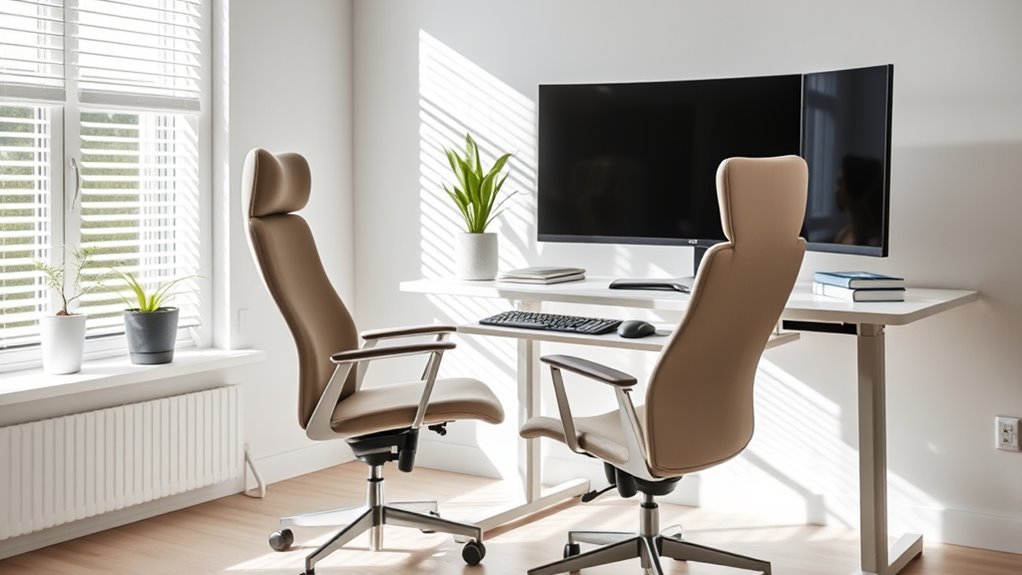To set up an ergonomic home office, start by measuring your space and choosing furniture that fits well and supports good posture, like an adjustable desk and chair with lumbar support. Position your monitor at eye level and keep your keyboard and mouse within easy reach. Guarantee proper lighting to reduce glare, and incorporate movement breaks throughout the day. If you continue exploring, you’ll find tips to make your workspace even more comfortable and efficient.
Key Takeaways
- Measure your space and choose adjustable furniture to ensure comfort and support proper posture.
- Position your monitor at eye level, about an arm’s length away, with the keyboard and mouse at a 90-degree elbow angle.
- Incorporate good lighting, using task lamps and blinds to minimize glare and eye strain.
- Use ergonomic accessories like supportive chairs, footrests, and adjustable monitor arms for optimal alignment.
- Schedule regular breaks and stretching exercises to promote movement, reduce stiffness, and maintain focus.
Assess Your Space and Choose the Right Furniture
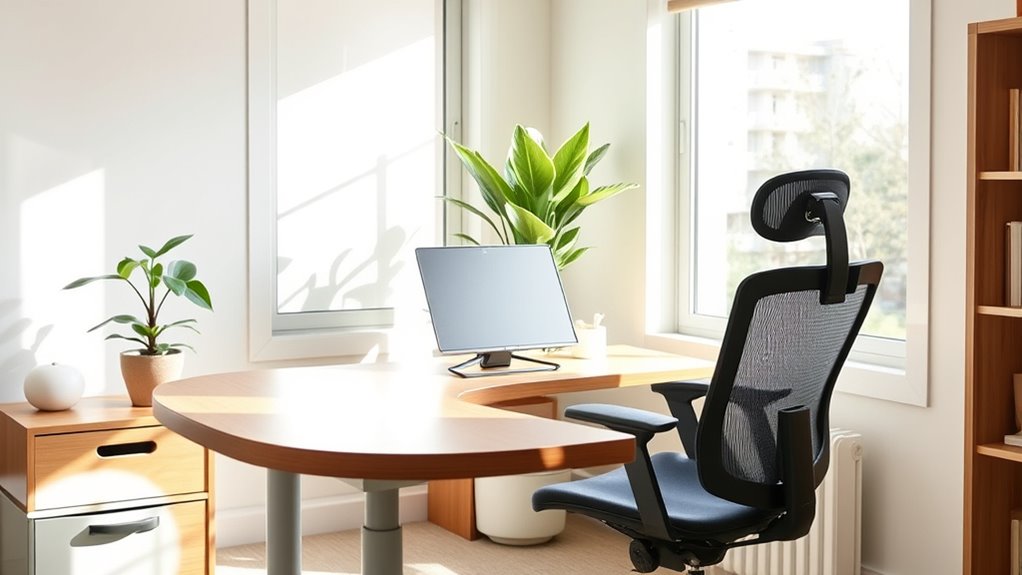
Before selecting furniture, you should evaluate your available space to make certain everything fits comfortably and promotes good posture. Start by measuring your room to ensure your desk and chair won’t overcrowd the area. Consider how much space you need for desk organization, like drawers or shelves, to keep your workspace tidy. Think about your preferred color scheme; choosing calming, neutral tones can boost focus and reduce stress. Select a desk that fits both your tasks and your room’s proportions. Make sure the furniture you choose supports good ergonomics, like adjustable height options. Additionally, understanding home theatre projector technology can help you select equipment that enhances your overall workspace experience. Properly appraising your space ensures your setup is functional, comfortable, and visually appealing, creating a solid foundation for an ergonomic home office. Exploring ergonomic accessories can further improve comfort and productivity in your workspace.
Position Your Desk and Monitor for Optimal Comfort
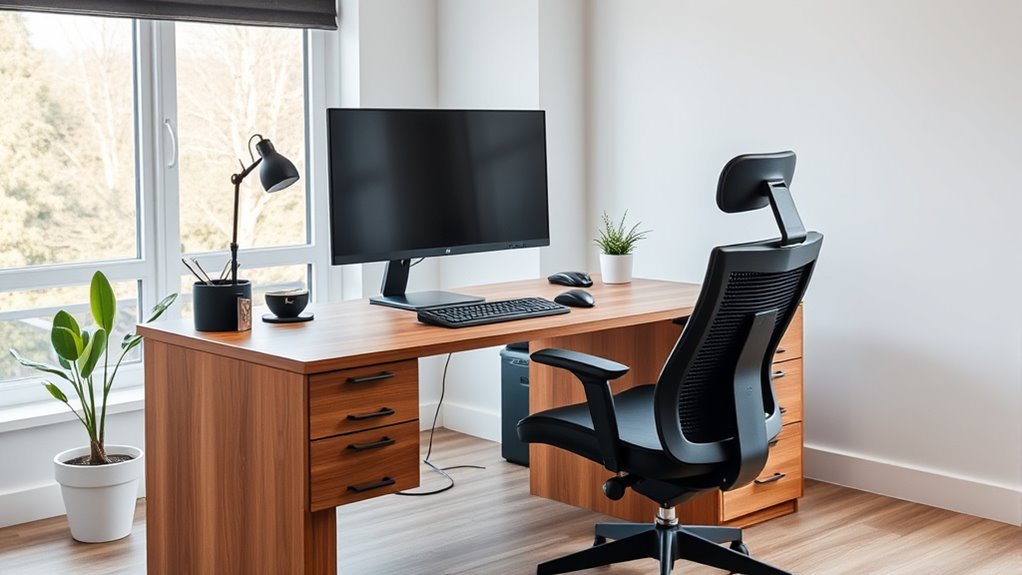
Once you’ve selected the right furniture and evaluated your space, the next step is to position your desk and monitor for maximum comfort. Proper monitor placement is key: the top of your screen should be at eye level, about an arm’s length away, to prevent neck strain. Adjust your desk height so your elbows form a 90-degree angle when typing, keeping your wrists straight. Your chair should support your lower back and allow your feet to rest flat on the floor. Make sure your monitor is directly in front of you, avoiding glare from windows or lights. This setup minimizes strain and promotes good posture. Taking the time to optimize your desk height and monitor placement creates a comfortable, ergonomic workspace that boosts productivity. Remember to consider ergonomic principles when arranging your workspace to ensure long-term comfort and health. Incorporating AI-driven ergonomic assessments can further help tailor your setup to your specific needs. Ensuring proper monitor positioning can also help reduce eye strain and improve overall comfort during long work sessions. Proper ergonomic setup can also prevent repetitive strain injuries and enhance your overall well-being during work hours.
Select Ergonomic Office Equipment and Accessories
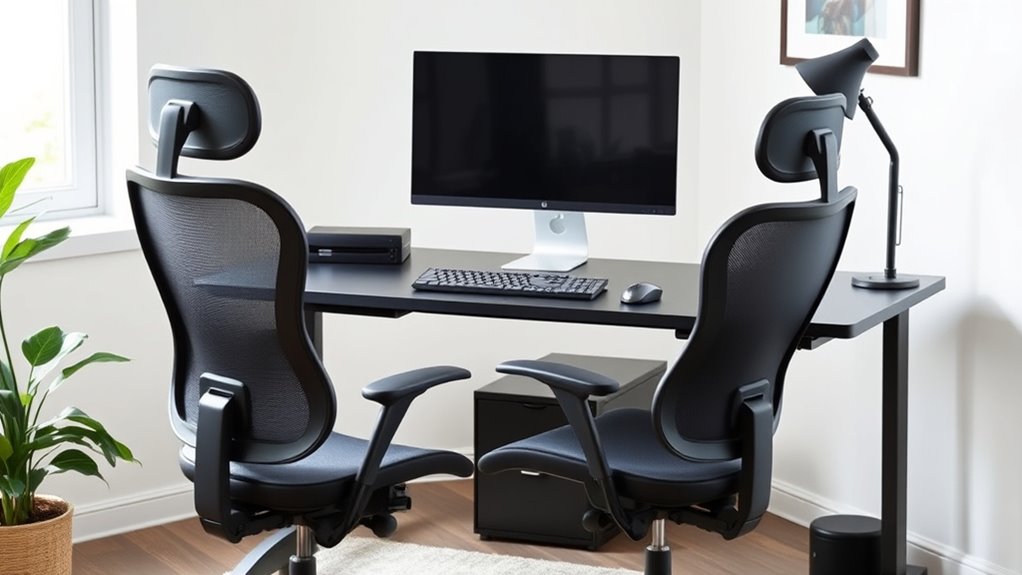
Choosing the right ergonomic office equipment and accessories is essential for maintaining comfort and preventing strain during long work sessions. When selecting ergonomic accessories, focus on items that support your posture and reduce repetitive stress. A new sentence with air purifier technologies and the rest of the sentence. Here are three must-have items: 1. An ergonomic keyboard with built-in wrist support, enabling you to use keyboard shortcuts comfortably without strain. 2. Adjustable monitor arms that keep your screen at eye level, reducing neck tension. 3. A supportive footrest to promote proper leg positioning and improve circulation. Investing in these ergonomic accessories ensures you work more efficiently and comfortably, while minimizing discomfort. Remember, the right equipment makes a difference in your productivity and overall well-being during extended work hours.
Arrange Your Seating for Proper Support
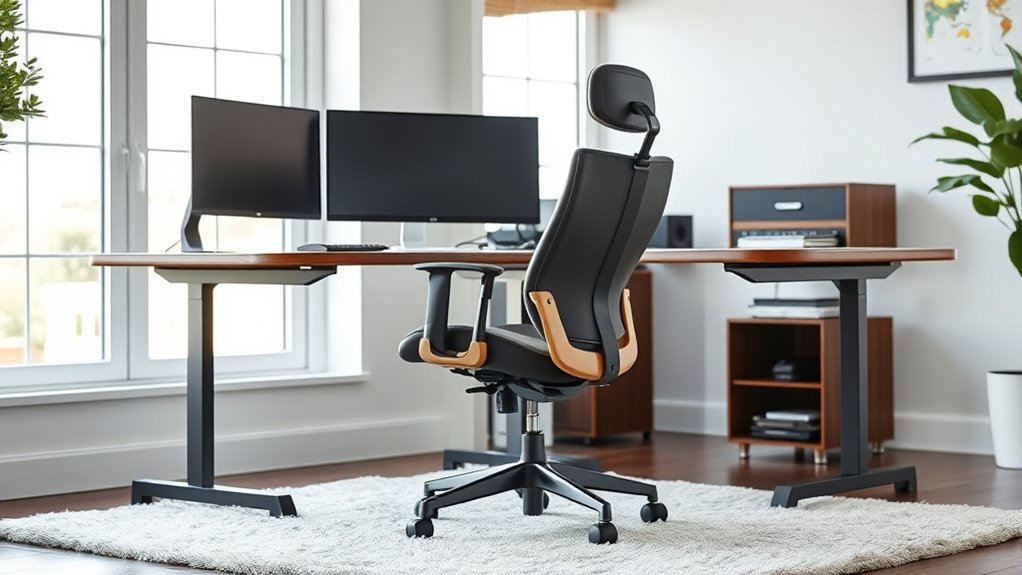
Start by adjusting your chair height so your feet rest flat on the floor and your knees are at a 90-degree angle. Use lumbar support to maintain the natural curve of your lower back and prevent discomfort. Keep good posture by sitting upright, with your shoulders relaxed and your screen at eye level. Incorporate ergonomic principles into your setup to further reduce strain and improve comfort throughout your workday. Additionally, consider using fabric decorating markers to personalize your workspace accessories for a more inviting environment. For enhanced comfort, explore Hyundai Tuning options for ergonomic vehicle seats that can inspire your home office chair adjustments. Understanding dream symbols related to comfort and stability can also help in creating a workspace that fosters well-being and productivity.
Adjust Chair Height
To guarantee your chair provides proper support, you need to adjust its height so that your feet rest flat on the floor and your knees are at a 90-degree angle. Proper seat adjustment ensures you avoid strain and fatigue. Focus on setting the chair height so that your hips are slightly higher than your knees, promoting good posture. Incorporating ergonomic furniture into your workspace can further enhance comfort and reduce the risk of strain. Here are three ways to make it happen:
- Raise or lower the chair until your feet are comfortably flat—no dangling toes.
- Adjust the seat height so that your hips are level with or slightly above your knees.
- Confirm that your thighs are parallel to the ground, supporting your lower back naturally. Utilizing preppy dog names can also add a touch of personality to your workspace, making it a more inviting environment. Ensuring your chair height aligns with proper ergonomic principles can prevent discomfort and keep you energized throughout the day. Additionally, sound healing science suggests that maintaining good posture can positively influence your mental focus and overall well-being. Paying attention to macros can also help maintain your energy levels during long work hours.
Use Lumbar Support
Proper lumbar support is essential for maintaining the natural curve of your lower back and preventing strain. Using lumbar support helps keep your spine aligned, reducing the risk of back pain. You can achieve this by selecting a chair with built-in lumbar support or adding a cushion specifically designed for this purpose. Adjust the support so it fits snugly into the curve of your lower back, promoting proper posture throughout your workday. When your lumbar region is well-supported, it eases pressure on surrounding muscles and ligaments, which is a key factor in back pain prevention. Additionally, choosing an ergonomic chair that offers adjustable features can further enhance your spinal alignment and comfort. Ensuring your workspace is set up properly can also contribute to ergonomic comfort, minimizing the chances of discomfort during prolonged sitting. Incorporating proper seating posture into your routine can significantly reduce the likelihood of developing back issues. Don’t overlook this step—proper lumbar support ensures you stay comfortable and healthy during long hours at your home desk.
Maintain Proper Posture
Ensuring your seating arrangement provides proper support is essential for maintaining good posture throughout your workday. To stay comfortable and avoid strain, focus on these key factors:
- Adjust your keyboard placement so your elbows stay close to your sides, reducing shoulder tension.
- Keep your feet flat on the floor or on a footrest to make sure proper foot positioning and promote stability.
- Sit back fully in your chair, with lumbar support supporting your lower back, encouraging a natural spine alignment.
Optimize Lighting and Reduce Glare
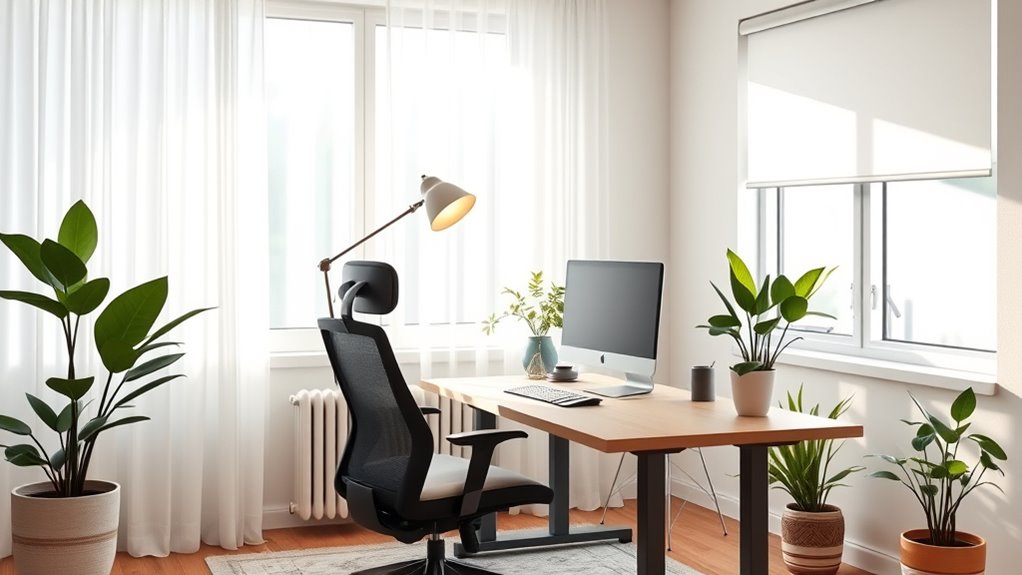
Optimizing your lighting setup is essential for reducing eye strain and maintaining focus throughout your workday. Start by incorporating task lighting directly at your workstation, such as a desk lamp with adjustable brightness, to illuminate your work area without causing shadows or glare. Position your primary light source behind or to the side of your monitor to minimize reflections. Use curtains or blinds to control natural light, preventing harsh sunlight from creating glare on your screen. Consider using matte or anti-glare screen protectors if necessary. Avoid placing bright lights directly behind or in front of your monitor, as this can cause distracting glare. Proper lighting adjustments help you stay comfortable and focused, reducing fatigue and improving productivity.
Incorporate Movement and Breaks Into Your Routine
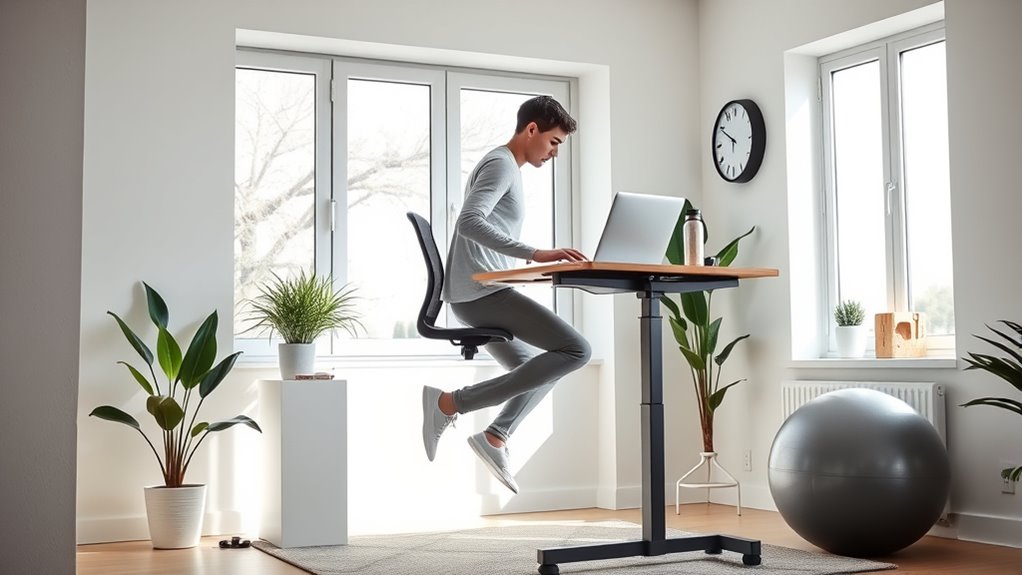
To stay energized and avoid fatigue, you should schedule regular movement breaks throughout your day. Incorporate stretching exercises and use active work strategies, like standing or walking during tasks. These habits will help you maintain focus and prevent stiffness in your muscles.
Schedule Regular Movement Breaks
Incorporating regular movement breaks into your work routine is essential for maintaining productivity and preventing discomfort. Setting activity reminders helps you stay on track and avoid staying sedentary for too long. These pauses are your chance to refresh and reduce strain.
Here are three ways to make the most of your movement breaks:
- Use alarms or apps to trigger activity reminders, ensuring you don’t forget.
- Stretch your neck, shoulders, and back to relieve tension.
- Walk around your space for a few minutes to boost circulation and energy.
Incorporate Stretching Exercises
Adding stretching exercises to your routine can considerably reduce muscle tension and improve flexibility during your workday. Incorporate simple flexibility exercises and stretching routines into your breaks to stay limber and alert. For example, shoulder rolls or neck stretches can help loosen tight muscles. Regularly performing these movements prevents stiffness and enhances circulation. To keep it organized, try this quick guide:
| Stretching Routine | Benefits |
|---|---|
| Neck stretches | Relieves tension in shoulders and neck |
| Arm and shoulder stretches | Improves upper body flexibility |
| Back stretches | Reduces lower back strain |
| Leg stretches | Prevents cramps and stiffness |
Use Active Work Strategies
Integrating regular movement and breaks into your work routine can considerably boost your energy and productivity. To stay active, try these strategies:
- Switch to a standing desk for 15-minute intervals to reduce fatigue and improve circulation.
- Use an ergonomic keyboard to prevent strain and encourage proper posture during short breaks.
- Incorporate quick stretching or walking every hour to refresh your mind and muscles.
These small changes make a big difference in avoiding stiffness and fatigue. Standing desks and ergonomic keyboards support your comfort, making movement easier and more natural. By actively planning breaks and shifting positions, you stay energized, focused, and healthier throughout your workday. Consistent movement isn’t just beneficial—it’s essential for maintaining your well-being.
Frequently Asked Questions
How Can I Personalize My Ergonomic Setup for Different Tasks?
You can personalize your ergonomic setup by incorporating task-specific accessories like adjustable monitors, keyboard stands, or foot rests to suit each activity. Use adjustable furniture to easily switch positions, ensuring comfort whether you’re typing, reading, or video conferencing. By customizing your workspace with these tools, you optimize comfort and productivity for every task, making your home office adaptable and supportive for your unique needs throughout the day.
What Are Cost-Effective Ways to Upgrade My Home Office Ergonomics?
Did you know that even small ergonomic improvements can boost productivity by 10%? To upgrade your home office affordably, consider adding budget-friendly accessories like adjustable keyboard trays or cushioned wrist rests. You can also make DIY modifications, such as stacking books to raise your monitor or creating your own footrest. These simple, cost-effective tweaks help you work comfortably without breaking the bank.
How Do I Maintain Ergonomic Principles With Small or Unconventional Spaces?
In small or unconventional spaces, you can maintain ergonomic principles by choosing compact furniture that fits comfortably without crowding your area. Use creative storage solutions to keep your workspace organized and free of clutter, which helps you sustain good posture and focus. Elevate your monitor to eye level and ensure your chair supports your back. Prioritize comfort and organization to create an ergonomic environment, even in limited spaces.
What Specific Adjustments Are Recommended for People With Pre-Existing Health Issues?
Think of your body as a delicate garden needing customized care. For pre-existing health issues, you should adopt adaptive seating that supports your specific needs and incorporate assistive devices for added stability. Adjust your workstation to reduce strain, like pruning overgrown branches. These tailored modifications help you maintain comfort and prevent discomfort, ensuring your workspace nurtures your well-being just as a well-tended garden flourishes with thoughtful attention.
How Often Should I Reassess and Tweak My Ergonomic Setup?
You should perform a routine review of your ergonomic setup every few months to guarantee it continues to meet your needs. Pay attention to ergonomic milestones, such as comfort levels and any discomfort or pain. If you notice issues, tweak your workstation accordingly. Regular reassessment helps prevent strain and keeps your workspace optimized for your health, making sure you stay comfortable and productive over time.
Conclusion
Creating an ergonomic home office boosts comfort and productivity. Did you know that taking regular breaks can increase focus by 13%? By evaluating your space, choosing supportive furniture, and incorporating movement, you’ll work more efficiently and reduce discomfort. Remember, small adjustments make a big difference—your body will thank you for it. So set up your space thoughtfully, stay active, and enjoy a healthier, more comfortable work-from-home experience.

